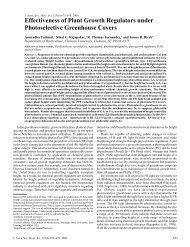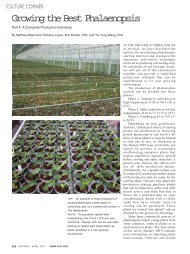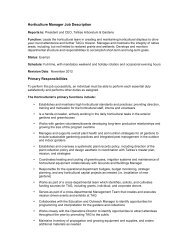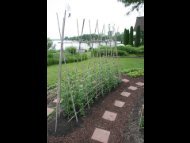Individual Greenhouse Energy Conservation Checklist
Individual Greenhouse Energy Conservation Checklist
Individual Greenhouse Energy Conservation Checklist
You also want an ePaper? Increase the reach of your titles
YUMPU automatically turns print PDFs into web optimized ePapers that Google loves.
<strong>Individual</strong> <strong>Greenhouse</strong> <strong>Energy</strong> <strong>Conservation</strong> <strong>Checklist</strong>(Adapted from a checklist developed by John W. Bartok Jr., Professor Emeritus, University of Connecticut byA.J. Both, Rutgers University, and Paul Fisher, University of New Hampshire) Feb 2006Structure #/name _______________Approximate year built __________Dimensions and space useSize: total width _____ ft. bay width _____ ft. number of bays:______ length _____ ft.Square feet of floor space:__________ Sq. ft. of bench/floor space covered by crops:___________% Space utilization (floor area used for crop production/total floor space)?_________________Number of hanging baskets:____________sq.ft. of floor space per hanging basket:__________List main crops [in general groups (e.g. plugs)] grown in the greenhouse at different times of year:Crop type Months sq.ft. of greenhouse space filledIs the greenhouse used for production?____________ retail?____________Are crops grown on floor ______, benches ______, overhead ______.Are plants grown in one or multiple levels (e.g. hanging baskets)? Yes NoIs a roll-out bench system used for spring bedding plant production? Yes NoIs the greenhouse completely filled with plants during the time it is heated? Yes NoSuggestions to improve space utilization:___________________________________________________________________________________________________________________________________________________________________________________________________________________________________________________________________________________1
<strong>Greenhouse</strong> cladding and leaksWhat type(s) of film/rigid panel/glass is(are) used?_____________________________________What is the condition of the glazing material? Excellent Good FairIf polyethylene film, does it have an IR barrier? Yes Nodoes it have a no-drip surface? Yes Nois it inflated using outside air? Yes NoWhich greenhouses surfaces are covered with a double layer (including multi-wall panels)?End walls Sidewalls RoofIs the greenhouse located in a wind sheltered area (without reducing sunlight)? Yes NoAre windbreaks installed around the greenhouse (without reducing sunlight)? Yes NoDoes the greenhouse feel drafty? Yes NoDo you observe any undesirable leaks/openings in the greenhouse cover? Yes NoAre doors/windows closing properly and kept closed when not in use? Yes NoDoes the ventilation window close properly? Yes NoDo the fan louvers close properly? Yes No NASuggestions in terms of glazing/leaks:____________________________________________________________________________________________________________________________Shade curtainIs a shade curtain installed? Yes NoIf yes, does the shade curtain also serve as energy blanket? Yes Nowhat is the shade factor (%) of the curtain?_______________________________what is the energy savings factor (%) of the curtain?________________________what is the control strategy followed for closing the curtain to conserve energy?________________________________________________________________________what is the control strategy followed for opening the curtain after a cold night?________________________________________________________________________what is the control strategy for using the curtain as shade screen?________________________________________________________________________Suggestions in terms of shade curtains:__________________________________________________________________________________________________________________________2
Did you observe any leaks in the hot water distribution system? Yes No NAAre the hot water heating pipes clean? Yes No NAAre the hot water distribution pipes insulated? Yes No NAAre hot water tanks close to largest and most frequent point of use? Yes No NAAre hot water distribution pipes all insulated? Yes No NAWhat is the temperature setting on the hot water storage tank? °F/ NAAre heat exchangers (e.g., located inside unit heaters) clean? Yes No NAAre heat exchangers (e.g., located inside unit heaters) clean? Yes No NAIs the unit heater or boiler power vented? Yes No NAWas the heating system serviced immediately before or during this cold season? YesIs there more than one heating stage (e.g. bench/perimeter zones or multiple units)? Yes NoIs there a backup heating source in case the main heater fails? Yes NoSuggestions in terms of heating system:__________________________________________________________________________________________________________________________Ventilation and CoolingIs the greenhouse naturally or mechanically ventilated? Naturally MechanicallyIf naturally, is the ventilation system motorized? Yes NoIf mechanically,is it an open-roof greenhouse? Yes Noare the fans AMCA rated (check seals) and do they have a VentilationEfficiency ratio larger than 15? Yes Noare the fan motors variable speed motors? Yes Noare the fans staged (and what is their staging)? Yes Noare the belts on the fans tightened and aligned properly? Yes Noare the blades balanced and in good condition? Yes NoAre outside doors routinely kept closed when the greenhouse is venting? YesAre indoor doors routinely kept closed between compartments? Yes No NADoes the greenhouse have an evaporative cooling system? YesIf yes, what type? Pad and Fan System Fog SystemDoes the grower report any humidity problems? Yes NoSuggestions in terms of ventilation:______________________________________________________________________________________________________________________________NoNoNo4
Insect ScreeningIs the ventilation opening outfitted with insect screening? Yes NoIf yes, what is(are) the type(s) of insect(s) that need to be screened out?__________________If yes, what is the mesh size (or opening size) of the screen material?____________________If yes, what is the pressure drop across the screen material?Inches of water gauge_______If yes, is the insect screen in good condition (i.e., without unwanted openings)? Yes NoIf yes, how often is the screening material cleaned?If yes, does the ventilation system provide adequate ventilation on warm summer days?Yes NoIf no, does the grower report insect problems? YesNoSuggestions in terms of insect screening:_________________________________________________________________________________________________________________________DrainageDoes rain and melt water drain away from the building properly? Yes NoIs there excess irrigation water on the floor Yes NoSuggestions in terms of drainage:_______________________________________________________________________________________________________________________________Conserving ElectricityAre electrical motors high efficiency? Yes NoWere any incandescent lamp bulbs replaced with fluorescent or HID bulbs? Yes NoWas a licensed electrician involved in design of the system YesHas the entire electric system been checked recently by a licensed electrician? Yes NoHow many phases does the electric system have?____________________________What is the voltage provided to the various electrical services?________________________Is there a backup generator? Yes NoSuggestions in terms of electricity:_________________________________________________________________________________________________________________________No5
Equations, figures and tables useful for heat calculations:Step 1: Determine greenhouse dimensions (in feet).Wall height A =House width B =House length C =Rafter Length D =Lower wall height E =Upper wall height F =Gable height G or H =Step 2: Calculate surface areas (in ft 2 ) and perimeter distance (in ft)Note: N is the number of greenhouse bays. N = 1 for a single bay greenhouse.Lower wall area: 2N(E x B) + (E x 2C) =Upper wall area: 2N(F x B) + (F x 2C) =Single material wall: 2N(A x B) + (A x 2C) =Gable-style greenhouse roof surface area: 2N x D x C =Gable-style greenhouse gable area (end wall above gutter): N x B x G =Curved-roof style greenhouse roof surface area: N x D x C =Curved-roof style greenhouse gable area (end wall above gutter): 1.1N x B x H =Hoop-house end wall area: 1.5N x B x H =Perimeter: 2[(N x B) + C] =Step 3: Determine U-values for each material used in the various surface areas.Lower wall area: U 1 =Upper wall area: U 2 =1
Step 5: Calculate the perimeter heat loss (Q P in Btu/hr)Q P = Perimeter heat loss factor x Perimeter x ΔTFor perimeter heat loss factor, use a value of 0.4 or 0.8 Btu/hr per linear foot of perimeterper °F depending on whether the perimeter is insulated or not.Step 6: Calculate the greenhouse volume (in cubic feet)Gable-style greenhouse volume: N[(A x B x C) + (B x G x C/2)] =Single curved roof greenhouse volume: 2H x B x C/3 =Multiple curved roof greenhouse volume: N[(A x B x C) + (2H x B x C/3)] =Step 7: Calculate the infiltration heat loss (Q A in Btu/hr)Q A = 0.02 x <strong>Greenhouse</strong> volume x Air exchanges per hour x ΔT =For air exchanges per hour use the following table.Type of constructionAir exchanges per hourNew, glass 0.75 - 1.5New, double poly 0.50 - 1.0Old, glass and in good condition 1.0 – 2.0Old, glass and in poor condition 2.0 – 4.0Step 8: Calculate the total heat loss (Q T in Btu/hr)Q T = Q STRUC + Q P + Q A =Adjustment to the heat loss calculations should be made for situations with a large ΔTand/or locations with high average wind velocities: If ΔT is larger than 70°F, and if theaverage wind velocity is larger than 15 mph, multiply the calculated total heat loss by: (1 +0.08) for every increase in ΔT of 5°F above 70°F and (1 + 0.04) for every 5 mph increasein average wind velocity above 15 mph. For example, if ΔT = 80°F and the average windvelocity is 25 mph, multiply the calculated total heat loss by a factor of: 1 + (0.16 + 0.08) =1.24.If the greenhouse heating system is designed properly, the capacity of the heating systemshould match the calculated total heat loss Q T (that is the predicted heat loss on thecoldest night). Make sure that the heating system has an output rating that equals thecalculated total heat loss. When the heating system is rated by input, multiply this valueby the efficiency of the system (generally in the 70-80% range) to determine the ratedoutput.Additional reading:Aldrich, R.A. and J.W. Bartok. 1994. <strong>Greenhouse</strong> Engineering, NRAES Publication No.33. Natural Resource, Agriculture, and Engineering Service. P.O. Box 4557 Ithaca, NY14852. http://www.nraes.org.Bartok, J. W. 2001(revision). <strong>Energy</strong> <strong>Conservation</strong> for Commercial <strong>Greenhouse</strong>s. NRAESPublication No. 3. Natural Resource, Agriculture, and Engineering Service. P.O. Box4557 Ithaca, NY 14852. http://www.nraes.org.3
















